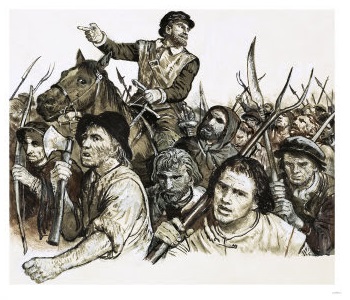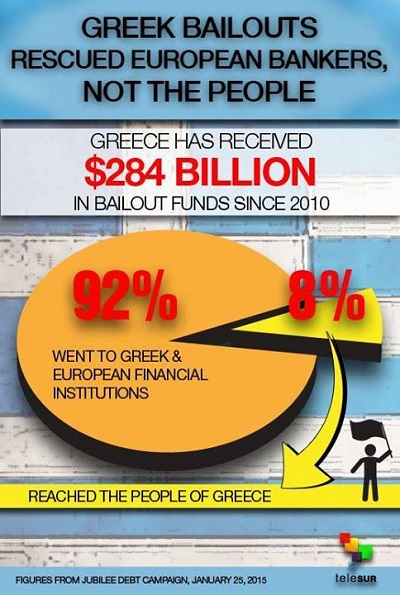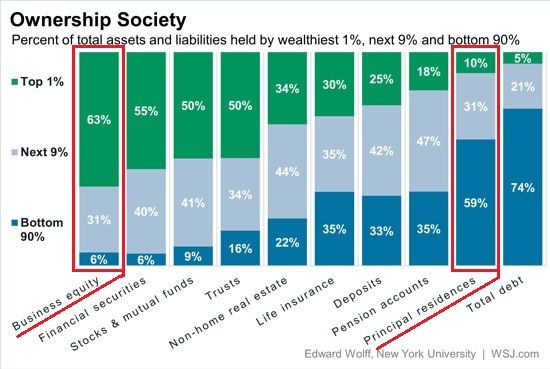Welcome to Neocolonialism, Exploited Peasants!

In my latest interview with Max Keiser, Max asked a question of fundamental importance: (I paraphrase, as the interview has not yet been posted): now that the current iteration of capitalism has occupied every corner of the globe, where can it expand to for its “growth”?
My answer: neocolonialism, my term for the financialized quasi-colonial exploitation of the home domestic population. I described this dynamic in The E.U., Neofeudalism and the Neocolonial-Financialization Model(May 24, 2012).
We all know how old-fashioned colonialism worked: the imperial power takes political and economic control of previously independent lands.
In the traditional colonial model, there are two primary benefits:
1. The imperial power (the core) extracts valuable commodities and low-cost labor from its colony (the periphery)
2. The imperial power sells its own high-margin manufactured goods to the captured-market of its colony.
This buy low, sell high dynamic is the heart of colonialism, which can be understood as one example of the The Core-Periphery Model (June 11, 2013).
The book Sweetness and Power: The Place of Sugar in Modern History is an excellent history of how this model worked for Great Britain.
The Imperial Core controls finance and credit via its multinational banking sector, and it maintains high profit margins via its state-cartel model of production. The state enforces a cartel-crony-capitalist pricing structure in which competition is strictly limited to street stalls and black markets, and the corporatocracy can raise prices at will: for example, pharmaceutical products such as Epi-Pens can be repriced at will from $60 to $600 each.
If the colonists resist, the resisters are silenced and the media brought under control of the Imperial Deep State. (Sound familar? It should.)
This traditional model of colonialism was forcibly dismantled in the 1940s-1960s. Former colonies established their political independence, a process that diminished the wealth and global reach of former colonial powers.
In response, global financial powers sought financial control rather than political control. This is the key dynamic in the Neocolonial-Financialization Model, which substitutes the economic power of financialization (debt, leverage and speculation fueled by globalized mobile capital) for the raw power of political conquest.
The main strategy of financialization is: extend cheap credit to those with limited access to capital. Those with limited access to capital will agree to penalties, high interest rates, etc. because they have no other way to acquire a university degree, a mortgage, a vehicle, etc.
These tactics have been well-documented in books such as The Shock Doctrine: The Rise of Disaster Capitalism and Confessions of an Economic Hit Man.
But the economic pillaging of former colonies has limits, and as a consequence the Imperial financial powers developed the Neocolonial Model, which turns these same techniques on their domestic populations.
In the E.U. version of Neocolonialism, the forces of financialization are used to indenture the peripheral Elites and populaces to the financial core: the peripheral “colonials” borrow money to buy the finished goods manufactured in the core economies, enriching the ruling Elites with A) the profits made selling goods to the debtors B) interest on credit extended to the peripheral colonies to buy the core economies’ goods and “live large”, and C) the transactional skim of financializing peripheral assets such as real estate and State debt.
In essence, the core banks of the EU colonized the peripheral nations via the financializing euro, which enabled a massive expansion of debt and consumption in the periphery. The banks and exporters of the core extracted enormous profits from this expansion of debt and consumption.
Now that the financialization scheme of the euro has run its course, the periphery’s neocolonial standing is starkly revealed: the assets and income of the periphery are flowing to the core as interest on the private and sovereign debts that are owed to the core’s central bank and its money-center private banks.
Note how little of the Greek “bailout” actually went to the citizenry of Greece and how much was interest paid to the financial powers.

This is not just the perfection of neocolonialism but of neofeudalism as well. The peripheral nations of the EU are effectively neocolonial debtors of the core, and the taxpayers of the core nations are now feudal serfs whose labor is devoted to making good on any loans to the periphery that go bad.
Neocolonialism benefits the financial Aristocracy of both the core and periphery. This is ably demonstrated in the recent essay Misrule of the Few: How the Oligarchs Ruined Greece.
In the U.S., the Neocolonial-Financialization Model now dominates the U.S. economy. America’s debt-serfs now toil their entire lives to pay down student loans, mortgages, auto loans and a host of other debts. High debt loads stripmine their earnings (already declining due to hidden inflation) and makes it difficult to acquire any income-producing assets of their own.
Note that the wealthy own productive assets while the peasantry “own” debt.

We are now reaching the limis of the predatory, parasitic Neocolonial-Financialization Model. There are no more markets to exploit with financialization, the incomes of the debt-serfs have stagnated to the point they cannot take on any more debt and the reality that the mountains of debt are unpayable can no longer be masked.
No wonder the Ruling Elite Has Lost the Consent of the Governed. The U.S. peasantry has been stripmined exactly like the powerless colonial peasantry in the old colonial model, and they are finally identifying their oppressors: the ruling Elite of the U.S.
My new book is #8 on Kindle short reads -> politics and social science: Why Our Status Quo Failed and Is Beyond Reform ($3.95 Kindle ebook, $8.95 print edition)For more, please visit the book’s website.
Leave a Reply